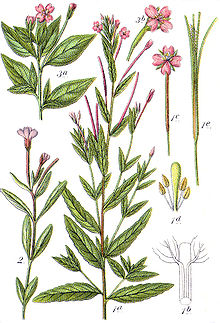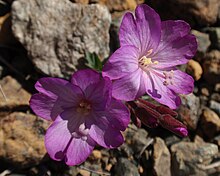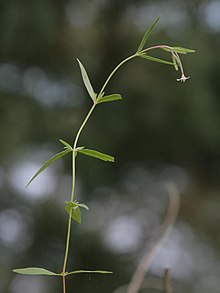Willowherb
| Willowherb | ||||||||||||
|---|---|---|---|---|---|---|---|---|---|---|---|---|

Shaggy fireweed ( Epilobium hirsutum ) |
||||||||||||
| Systematics | ||||||||||||
|
||||||||||||
| Scientific name | ||||||||||||
| Epilobium | ||||||||||||
| L. |
The fireweed ( Epilobium ) is a genus of plants within the family of the evening primrose family (Onagraceae). The up to 190 species , depending on the author, are distributed in the temperate areas of North America and Eurasia ( Holarctic ).
Description and ecology



Appearance and leaves
Epilobium species grow as annual to perennial herbaceous plants or rarely as subshrubs . There are offshoots or Turione (underground globular buds formed with fleshy scales). The above-ground parts of the plant are densely hairy to bald ( indument ). The upright to prostrate stems are hairy or glabrous, often with lines of trichomes running down the stem from the petioles.
The often opposite, rarely lively arranged leaves are stalked or sitting. Basal leaf rosettes are formed. In 2011, Sennikov placed the species with alternate leaves in a separate genus: Chamaenerion Ség. (Syn .: Chamerion Raf. Ex Holub ); within the genus Epilobium they otherwise belong in a separate section : Sect. Chamaenerion exchange . There are no stipules .
Inflorescences and flowers
The racemose , panicle , spike or umbrella-like inflorescences can be simple or branched. There are no cover sheets .
The hermaphroditic, often relatively small flowers are fourfold and often protandric . There are two unequal circles with four stamens each. The yellow pollen grains are distributed in tetrads. The upright style ends in a simple or four-lobed scar.
They have reddish, pink or whitish flowers. Many species have a long corolla tube. The flowers are radial symmetry or, according to some authors, can be zygomorphic . According to Sennikov 2011, the species with zygomorphic flowers are again placed in their own genus: Chamaenerion Ség. (Syn .: Chamerion Raf. Ex Holub ); within the genus Epilobium they otherwise belong in a separate section: Sect. Chamaenerion exchange .
Fruits and seeds
The narrow, linear, loculicidal capsule fruit pops open with four flaps, from which the mostly large number of seeds emerge. The seeds often have silky-haired appendages at the top for the wind to spread ( anemochory ).
Sets of chromosomes
There were chromosome numbers of 2n = 18, 20, 24, 26, 28, 30, 32, 36, 38, 60 determines the most frequently is 2n = 36th
Systematics and distribution




The genus Epilobium was established by Carl von Linné . Epilobium hirsutum L. was specified as the lectotype species in 1913 by Nathaniel Lord Britton and Addison Brown in An Illustrated Flora of the Northern United States , 2nd Edition, Volume 2, p. 590. Synonyms for Epilobium L. are: Boisduvalia Spach , Cordylophorum Rydb. , Cratericarpium Spach , Crossostigma Spach , Pyrogennema Lunell , Zauschneria C.Presl .
The genus Epilobium belongs to the tribe Epilobieae in the subfamily Onagroideae within the family Onagraceae .
There are nearly 190 species worldwide. Some species tend to Hybridism (hybrids).
The following species occur in Europe:
- Whorled willowherb ( Epilobium alpestre (Jacq.) Krocker )
- Morenblättriges fireweed ( Epilobium alsinifolium Vill. )
- Gauch-leaved fireweed ( Epilobium anagallidifolium Lam. )
- Narrow-leaved willowherb ( Epilobium angustifolium L. , Syn .: Chamaenerion angustifolium (L.) Scop. , Chamerion angustifolium (L.) J.Holub )
- Epilobium atlanticum litard. & Maire , occurs in the Sierra Nevada in southern Spain and in North Africa.
- Kurzfrüchtiges fireweed ( Epilobium brachycarpum C.Presl ): It occurs in the United States and in Mexico. The plant was first registered in Germany in 1994. In 2016 the invasive neophyte was found in the Upper Rhine Plain, the Wetterau, the Taunus and the Palatinate Forest and spread further, mainly on fallow gravel.
- Glandular fireweed ( Epilobium ciliatum Rafin. , Syn .: Epilobium adenocaulon Hausskn. )
- Hill willowherb ( Epilobium collinum C.C. Gmelin )
- Epilobium davuricum fish. ex Hornem. : It occurs in Scandinavia and Russia.
- Rosemary fireweed ( Epilobium dodonaei Vill. , Syn .: Chamaenerion dodonaei (Vill.) Schur , Chamerion dodonaei (Vill.) J.Holub )
- Epilobium duriaei Gay ex Gren. & Godr. : It occurs in the mountains of Western Europe.
- Fleischer's willowherb ( Epilobium fleischeri Hochst. , Syn .: Chamaenerion fleischeri (Hochst.) Fritsch , Chamerion fleischeri (Hochst.) J.Holub )
- Epilobium gemmascens C.A.Mey. , occurs on the Balkan Peninsula.
- Epilobium glandulosum clay. : It occurs in North America and is naturalized in parts of Northern Europe.
- Shaggy fireweed ( Epilobium hirsutum L. )
- Epilobium hornemannii Rchb. : It occurs in the Arctic and in North America.
- Hartheu-fireweed ( Epilobium hypericifolium exchange ) will, as a synonym for Epilobium montanum L. asked.
- Epilobium lactiflorum Hausskn. : It occurs in the Arctic of Eurasia and in North America.
- Arctic willowherb ( Epilobium latifolium L. , Syn .: Chamaenerion latifolium (L.) Sweet , Chamerion latifolium (L.) Holub ): It is widespread in North Asia, North America, Russia and Iceland.
- Gray-green willowherb ( Epilobium lamyi F.W.Schultz ), is also known as a subspecies. lamyi (FWSchultz) Nyman to Epilobium tetragonum L. provided.
- Lancet fireweed or lancet-leaved willowherb ( Epilobium lanceolatum Sebastiani & Mauri )
- Mountain fireweed ( Epilobium montanum L. )
- Epilobium nerterioides A. Cunn. : It occurs partially naturalized in New Zealand, Great Britain and Ireland.
- Nodding Willowherb ( Epilobium nutans F.W.Schmidt )
- Dark green willowherb ( Epilobium obscurum Schreber )
- Marsh willowherb ( Epilobium palustre L. )
- Epilobium paniculatum Nutt. ex Torrey & A.Gray : It occurs in North America and is a neophyte in Spain.
- Small-flowered willowherb ( Epilobium parviflorum Schreber )
- Rose-red fireweed ( Epilobium roseum Schreber )
- Square willowherb ( Epilobium tetragonum L. )
- Epilobium tundrarum Sam. : It occurs in Russia and in Arctic Asia.
- Epilobium vernonicum Snogerup : It occurs only in Greece.
Other species outside Europe are (selection):
- Epilobium bongardii Hausskn. : It occurs in Kamchatka, Sakhalin and the Kuriles.
- Epilobium canum (Greene) PHRaven : It occurs in three subspecies in the United States and Mexico.
- Epilobium densiflorum (Lindl.) Hoch & PHRaven : It is widespread from Canada to the United States to Mexico.
- Epilobium luteum Pursh : It occurs in western North America in Canada and the United States.
- Epilobium minutiflorum Hausskn. : It is widespread in West, Central and East Asia, India and Pakistan.
- Epilobium minutum Lindl. : It is common in Canada and the western United States.
- Epilobium septentrionale (DDKeck) RNBowman & Hoch : The home is California.
- Epilobium torreyi (S.Watson) Hoch & PHRaven : It is found in British Columbia and the western United States.
In 2011 Sennikov placed around eight species, which are mainly distributed in montane to arctic areas of the northern hemisphere (Holarctic), back into the genus Chamaenerion Ség. (Syn .: Chamerion (Raf.) Raf. Ex Holub , Chamaenerium Spach orth. Var.), For example:
- Narrow-leaved willowherb ( Chamaenerion angustifolium (L.) Scop. , Syn .: Epilobium angustifolium L. , Chamerion angustifolium (L.) J.Holub )
- Chamaenerion conspersum (Hausskn.) Kitam. (Syn .: Chamerion conspersum (Hausskn.) Holub , Epilobium conspersum Hausskn. , Epilobium reticulatum C.B. Clarke )
- Rosemary fireweed ( Chamaenerion dodonaei (Vill.) Schur , syn .: Epilobium dodonaei Vill. , Chamerion dodonaei (Vill.) J.Holub )
- Arctic willowherb ( Chamaenerion latifolium (L.) Sweet , Syn .: Epilobium latifolium L. )
FT-IR spectroscopy, which is based on attenuated total reflection ( ATR infrared spectroscopy ) and does not require time-consuming sample preparation , is a simple analytical method with over 90% probability of a positive-correct result to distinguish between epilobium species .
Fireweed as a weed and invasive species
In 2013, the Federal Agency for Nature Conservation of Germany determined for the American willowherb ( Epilobium ciliatum ) in its "nature conservation invasiveness assessment for non-native vascular plants living in the wild" that the willowherb does not displace any native species, but has hitherto unoccupied open spaces that some bird species need as an uncultivated habitat. Therefore, the glandular fireweed has been classified as invasive and should be restricted in its spread.
In the field of conventional agriculture willowherb (without differentiating the exact species) are mostly regarded as a yield-reducing "field weed" and controlled accordingly.
swell
- Werner Greuter, Hervé-Maurice Burdet, Guy Long (eds.): Med-Checklist. A critical inventory of vascular plants of the circum-Mediterranean countries . Vol. 4: Dicotyledones (Lauraceae - Rhamnaceae) . Conservatoire et Jardin Botanique, Genève 1989, ISBN 2-8277-0154-5 , pp. 249-252 .
- Peter Hamilton Raven: Epilobium L. In: TG Tutin, VH Heywood, NA Burges, DM Moore, DH Valentine, SM Walters, DA Webb (eds.): Flora Europaea . Volume 2: Rosaceae to Umbelliferae . Cambridge University Press, Cambridge 1968, ISBN 0-521-06662-X , pp. 308–311 (English, limited preview in Google Book Search).
- Jiarui Chen, Peter C. Hoch, Peter H. Raven: Epilobium Linnaeus , p. 411 - online with the same text as the printed work , In: Wu Zheng-yi, Peter H. Raven, Deyuan Hong (ed.): Flora of China. Volume 13: Clusiaceae through Araliaceae , Science Press and Missouri Botanical Garden Press, Beijing and St. Louis 2007, ISBN 978-1-930723-59-7 .
Individual evidence
- ↑ a b c d e f g h i j Jiarui Chen, Peter C. Hoch, Peter H. Raven: Epilobium Linnaeus , p. 411 - online with the same text as the printed work , In: Wu Zheng-yi, Peter H. Raven, Deyuan Hong (Ed.): Flora of China. Volume 13: Clusiaceae through Araliaceae , Science Press and Missouri Botanical Garden Press, Beijing and St. Louis 2007, ISBN 978-1-930723-59-7 .
- ↑ a b Epilobium at Tropicos.org. In: Flora of Pakistan . Missouri Botanical Garden, St. Louis
- ↑ a b c Alexander N. Sennikov: Chamerion or Chamaenerion (Onagraceae)? The old story in new words. In: Taxon. Volume 60, No. 5, 2011, pp. 1485-1488 ( abstract ).
- ^ Epilobium at Tropicos.org. In: IPCN Chromosome Reports . Missouri Botanical Garden, St. Louis
- ^ Epilobium at Tropicos.org. Missouri Botanical Garden, St. Louis, accessed July 30, 2015.
- ↑ a b c d e f g h i j k Epilobium in the Germplasm Resources Information Network (GRIN), USDA , ARS , National Genetic Resources Program. National Germplasm Resources Laboratory, Beltsville, Maryland. Retrieved July 29, 2015.
- ^ Smithsonian Institution: Epilobium classification.
- ↑ Federal Center for Nutrition: Short-fruited fireweed: invasive species spreads. July 27, 2016. Retrieved August 20, 2017 .
- ↑ S. Krajšek, P. Buh, A. Zega, Samo Kreft: Identification of Herbarium Whole Leaf samples of Epilobium species by ATR-IR Spectroscopy. In: Chemistry & Biodiversity , Volume 5, 2008, pp. 310-317. doi : 10.1002 / cbdv.200890028
- ↑ Nature conservation assessment of invasiveness of alien vascular plants for Germany
- ↑ Work diary 2014 of the fruit growing research institute Jork , p. 185
Web links
- Epilobium at Tropicos.org. In: Flora Mesoamericana . Missouri Botanical Garden, St. Louis
- Epilobium at Tropicos.org. In: Peru Checklist . Missouri Botanical Garden, St. Louis
- Search for "Epilobium" on the IUCN Red List of Threatened Species .